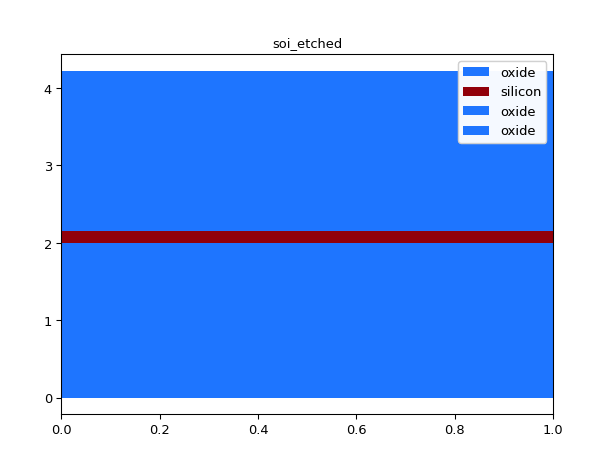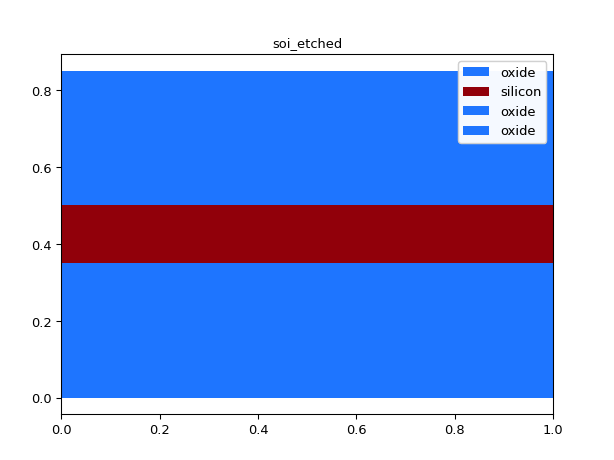camfr_compute_stack_neff
- ipkiss3.all.device_sim.camfr_compute_stack_neff(material_stack, environment=None, mode='TE0')
Computes the effective index of mode in the material stack at the given wavelength.
Warning
Calling this method will alter any camfr settings previously done by the user. Please ensure to apply any camfr settings (e.g. camfr.set_N()) for subsequent simulations in camfr after calling this function.
- Parameters:
- material_stackMaterialStack
A material stack that is used in the virtual fabrication.
- environmentEnvironment
Environment object, used to specify the wavelength.
- modestr
Chosen mode for computing the n_eff.
- Returns:
- float
Mode effective index at a given wavelength.
Examples
import ipkiss3.all as i3 from pysics.electromagnetics.material import Material from pysics.basics.material.material import MaterialFactory from pysics.basics.material.material_stack import MaterialStack, MaterialStackFactory from ipkiss.visualisation.display_style import DisplayStyle from ipkiss.visualisation.color import COLOR_SANGRIA, COLOR_BLUE_CRAYOLA from pysics.electromagnetics.environment import Environment layer_wg = i3.Layer(0) layer_rib = i3.Layer(1) layer_clad = i3.Layer(2) process_wg = i3.ProcessLayer(name="wg", extension="wg") process_rib = i3.ProcessLayer(name="rib", extension="rib") si = Material(name="silicon", display_style=DisplayStyle(color=COLOR_SANGRIA), epsilon=3.45 ** 2) ox = Material(name="oxide", display_style=DisplayStyle(color=COLOR_BLUE_CRAYOLA), epsilon=1.45 ** 2) mat_fact = MaterialFactory() mat_fact.si = si mat_fact.ox = ox soi = MaterialStack(name="soi", materials_heights=[(ox, 2.0), (si, 0.22), (ox, 2.0)], display_style=DisplayStyle(color=COLOR_SANGRIA)) soi_etched = MaterialStack(name="soi_etched", materials_heights=[(ox, 2.0), (si, 0.15), (ox, 0.07), (ox, 2.0)], display_style=DisplayStyle(color=COLOR_SANGRIA)) allox = MaterialStack(name="all oxide", materials_heights=[(ox, 2.0), (ox, 0.22), (ox, 2.0)], display_style=DisplayStyle(color=COLOR_BLUE_CRAYOLA)) matstack_fact = MaterialStackFactory() matstack_fact.soi = soi matstack_fact.soi_etched = soi_etched matstack_fact.allox = allox
To compute the effective index we call
camfr_compute_stack_nefffor each MaterialStack at the desired wavelength, and for the mode of choice. In this case it will beTE0.effective_indices = dict() # TE0 mode and the 1550 nm wavelength wavelength = 1.55 effective_indices[soi] = i3.device_sim.camfr_compute_stack_neff(material_stack=soi, environment=Environment(wavelength=wavelength), mode='TE0') # change the desired mode effective_indices[allox] = i3.device_sim.camfr_compute_stack_neff(material_stack=allox, environment=Environment(wavelength=wavelength), mode='TM0')
We can limit the stack to only take into account a certain portion when computing the effective index.
soi_etched.visualize()

clipped_soi_etched = soi_etched.clip_copy(z_min=1.65, z_max=2.5) clipped_soi_etched.visualize()

effective_indices[soi_etched] = i3.device_sim.camfr_compute_stack_neff(material_stack=clipped_soi_etched, environment=Environment(wavelength=wavelength), mode='TE0')